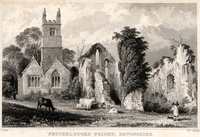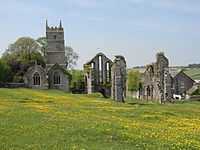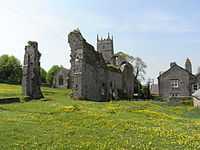Frithelstock
| Frithelstock | |
 Frithelstock | |
| OS grid reference | SS4619 |
|---|---|
| Shire county | Devon |
| Region | South West |
| Country | England |
| Sovereign state | United Kingdom |
| Police | Devon and Cornwall |
| Fire | Devon and Somerset |
| Ambulance | South Western |
| EU Parliament | South West England |





Frithelstock (pronounced Frizzlestock) is a parish, village and former manor in Devon, England. It is located within Torridge local authority area and formed part of the historic Shebbear hundred. In 2001 the population of the parish was 366.[1] The name derives from the Anglo-Saxon Frithulac's Stocc.[2] The ruins of Frithelstock Priory are adjacent to the north east side of the parish church of St Mary and St Gregory, and represent the only substantial remains of a monastic house in Devon.[3]
In 2013 the village has one public house, the Clinton Arms. The parish church of St. Mary & St. Gregory was enlarged in the 15th century and underwent a Victorian restoration in about 1870.[4]
Descent of the manor
Robert, Count of Mortain
The Domesday Book of 1086 lists Frelelestoch as one of the seventy-nine Devonshire holdings of Robert, Count of Mortain (c. 1031–1090), the half-brother of William the Conqueror. His tenant was Robert FitzIvo, who appears to have held no other lands in the county[5]
Beauchamp
Sir Roger de Beauchamp later held the manor.
Augustinian Friars
In about 1220[6] Sir Roger de Beauchamp donated a large part of the manor to the Augustinian priory dedicated to St Gregory he founded within it as a dependency of Hartland Abbey in North Devon.[7] Consequent to the Dissolution of the Monasteries, the prior relinquished possession of the priory and its demesne lands on 27 August 1536. Sir Thomas Arundell, the receiver of the Court of Augmentations in the counties of Devon, Cornwall, Dorset and Somerset, farmed the lands out to John Wynslade at an annual rent of £20 2s.[8] On 20 January 1537 the crown leased the lands for 21 years at the same rent to Sir George Carew of Mohun's Ottery. Carew immediately conveyed the lease to Wynslade. Wynslade was not long in possession as on 4 September 1537 the crown made a grant to Arthur Plantagenet, 1st Viscount Lisle (d.1542), an illegitimate son of King Edward IV, and his wife Honora Grenville, widow of Sir John Bassett (1462–31 Jan 1529) of Umberleigh, of "The site, church, etc., and demesne of Frithelstock Priory, the manor, rectory and advowson of the vicarage of Frithelstock and the manor of Broadwoodwidger, all late of the priory".[9] The estate was valued at about £92.[10] Risdon reckoned the priory and barton thus granted to containin a thousand acres.[11] Much of the negitiations fixing the purchase price payable by Lord Lisle to the crown are recorded in the Lisle Letters, the surviving correspondence between him and his London agent John Hussee.[12]
Walpole
The priory lands were later owned by Robert Walpole, 2nd Earl of Orford (d.1751), son of Robert Walpole (d.1745) the first prime minister, whose wife was Margaret Rolle, suo jure 15th Baroness Clinton (1709-1781), daughter and sole heiress of Samuel Rolle (1646–1719) of Heanton Satchville in the parish of Petrockstowe, about six miles south-east of Frithelstock.
Clinton
The lands may in fact have been Rolle property which Walpole held on behalf of his wife,[13] as they descended to Margaret Rolle's heirs, the Barons Clinton.
Other prominent families
Gay
The former priory lands were actually occupied under a lease since 1602 by a branch of the family of Gay of Goldsworthy in the parish of Parkham.[14] In 1810 the rectory building next to the parish church and the ruins of the priory were occupied by Mrs Gay, the widow of Rev. Gay, curate of Frithelstock.[15] A prominent member of the family was the poet John Gay (1685-1732), son of William Gay (1649-1695), who was baptised at Frithelstock.[16]
Stevens of Smythacott

The family of Stevens, formerly of Velstone, Buckland Brewer, later of Smythacott in the parish of Frithelstock and later of Cross, Little Torrington, was wealthy and influential. Henry Stevens (1698-1748) married Christiana Maria Rolle (1710-1780), a sister of Henry Rolle, 1st Baron Rolle (d.1759) of Stevenstone. Henry Stevens described himself in his will as "of Smithcott". Their inscribed ledger stone survives in the floor of the south aisle of Frithelstock parish church, inscribed as follows: "Here lie the bodies of Henry Stevens of Smythacott Esq., and Christiana Maria his wife sister of the late Henry Lord Rolle. Mr Stevens was buried on the 21st of January 1748 aged 50 and Mrs Stevens on the 19th of July 1780 aged 70". The coat of arms above the inscription has been worn away by footfall, but the falcon crest of Stevens is still discernible. Portraits of Christiana and of her brothers John Rolle Walter (1712-1779), and Denys Rolle (d.1797), successively owners of the Stevenstone estates, were painted by Thomas Hudson and were given in the early 1900s by Lord Clinton, the heir of Hon. Mark Rolle (d.1907) to the Great Torrington Town Lands And Poors Charity and are on public display in Great Torrington townhall. The Rolles of Stevenstone were the largest landowners on Devon. The Stevens family of Winscott, Peters Marland was later lord of the manor of Peters Marland and of Little Torrington and owned much land on the west side of the River Torridge west of Great Torrington. Smythacott is today a modest farmhouse, with no discernible trace remaining of the presumably grand house of the Stevens family. The Stevens family was at one time heir presumptive to the vast Devon estates of John Rolle, 1st Baron Rolle (d.1842).
Visit by Rev. John Swete


In October 1792 the Devon topographer Rev John Swete (1752-1821) visited the ruins of Frithelstock Priory in the company of Henry Stevens (1739-1802), son of Henry and Christiana Maria, whom he had visited at Cross. He relates the journey in his Journal thus: "Accompanied by Mr Stevens I went in quest of the Priory of Frithelstock, in the way to which we descended to the bridge at the SW end of Torrington, which passing over, we again rose up a steep hill, introducing us to a common precipitous towards the river but having a delightful prospect on the north of Beam a seat of Dennis Rolle Esq., a most lovely and sequestered spot, protected on every side by the richest woods of the finest amphitheatrical form, the roots of which were washed by the river which as if enamoured of the spot winds round it in many a meander and seems reluctant to retire from it. On the summit of an hill three miles from Cross, having again past the Towridge by another bridge, we came to the ruins of the priory, which tho' not grand nor extensive have a good deal of the picturesque in them and possess a peculiarity in the rounding of the western windows of the chapel, rarely if at all to be met with. The remains consist chiefly of the side and end walls of what is now one room, the area of which in length is 30 paces and in width about 9. There are two very antient walnut trees overhanging the southern walls and with the ivy contributing greatly to enhance its beauty".[17] Swete made a watercolour sketch of the priory, from the inside of the ruins looking toward the western wall, which survives in the Devon Record Office.[18]
1734 view by Buck

An engraving of the south-east view was made by Samuel & Nathaniel Buck in 1734, inscribed as follows: left: "To the Right Honourable ROBERT WALPOLE, Lord Walpole of Walpole, Clerk of the Rolls, one of the Gentlemen of his MAJESTYS Bedchamber, and Knight of the most honourable Order of the Bath, Proprietor of this Priory, This Prospect is humbly Inscrib'd by his Lordships most Obedt. Servts. Saml. & Nathl. Buck." In the centre is the coat of arms of Walpole, and on the right is inscribed: "This was a Priory of Canons regular, founded & endow'd by Robert de Bello Campo or Beauchamp, & dedicated to God the blessed Virgin & St. Gregory. The Patrons reserv'd to themselves a Power to Guard the Gate for the preservation of the priory, during the vacancy of a Prior & no longer. The Scite and Barton contain'd 1000 Acres which were given at the dissolution to Arthur Plantaginet, Viscount Lisle"
Sources
- Risdon, Tristram, Survey of Devon (c.1630), 1810 edition, pp. 275–6
- Hoskins, W.G., A New Survey of England: Devon, London, 1959
References
- ↑ Harris
- ↑ Eilert Ekwall, Concise Oxford Dictionary of English Place-names, Oxford, 1981
- ↑ Hoskins, p.399
- ↑ Harris, Helen, A Handbook of Devon Parishes, Tiverton, 2004
- ↑ Thorn, Caroline & Frank, Domesday Book, vol. 9: Devon, Chichester, 1985, part 1, chap. 15,10 & note in part 2
- ↑ Hoskins, p.399
- ↑ Hoskins, p.400
- ↑ Youings, Joyce, Devon Monastic Lands: Calendar of Particulars for Grants 1536-1558, Devon & Cornwall Record Society, New Series, Vol.1, pp.1-2
- ↑ Youings, p.1
- ↑ Youings, p.1
- ↑ Risdon, 1810 ed., p.276
- ↑ Youings, p.2
- ↑ Risdon, p.422
- ↑ Risdon, p.422
- ↑ Risdon, p.422
- ↑ Vivian, Lt.Col. J.L., (Ed.) The Visitation of the County of Devon: Comprising the Heralds' Visitations of 1531, 1564 & 1620, Exeter, 1895, p.394, pedigree of Gay
- ↑ Swete, Rev. John, Travels in Georgian Devon: the Illustrated Journals of the Reverend John Swete, 1789-1800, vol.1, ed. Gray, Todd, Tiverton, 1997, p.28
- ↑ DRO 564M/F1/101
External links
![]() Media related to Frithelstock at Wikimedia Commons
Media related to Frithelstock at Wikimedia Commons